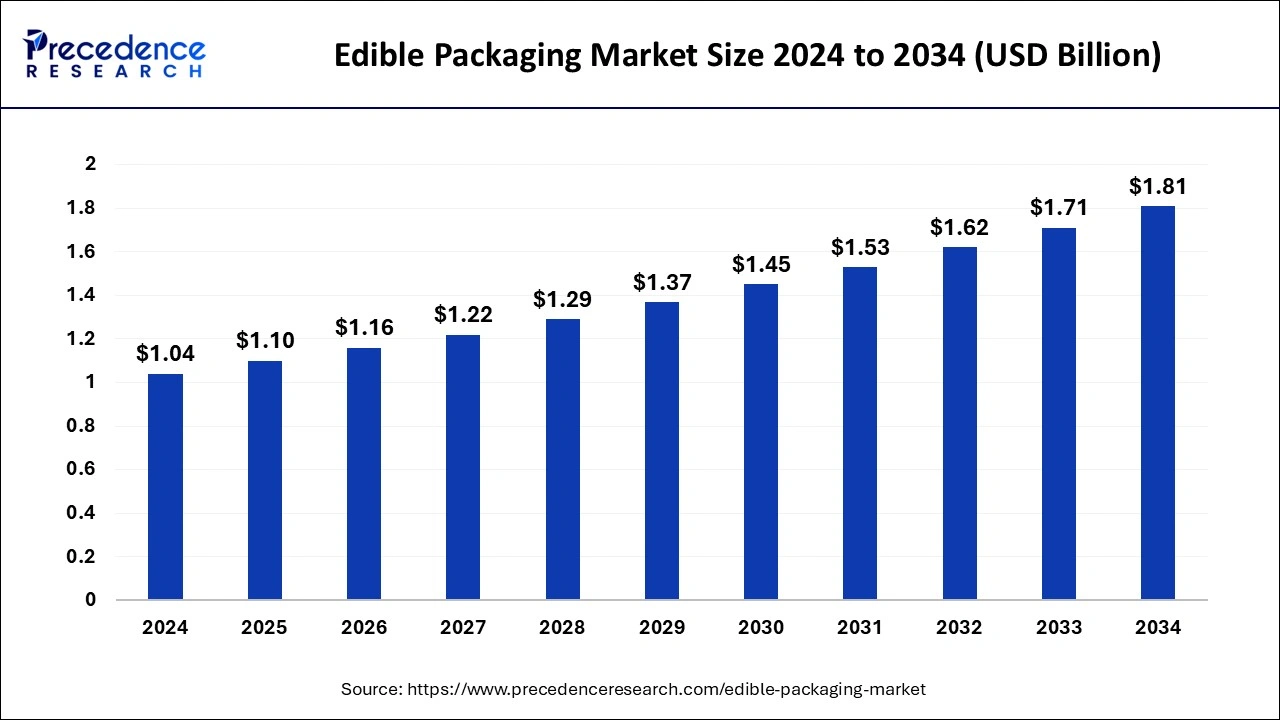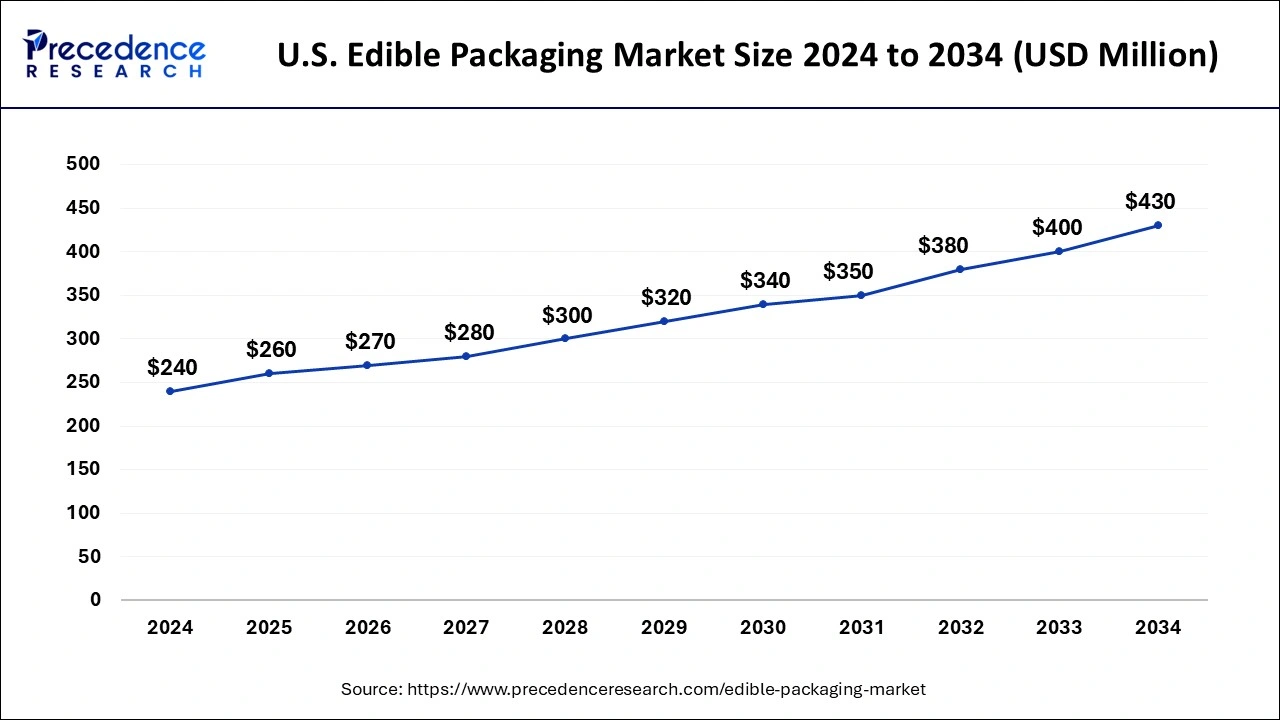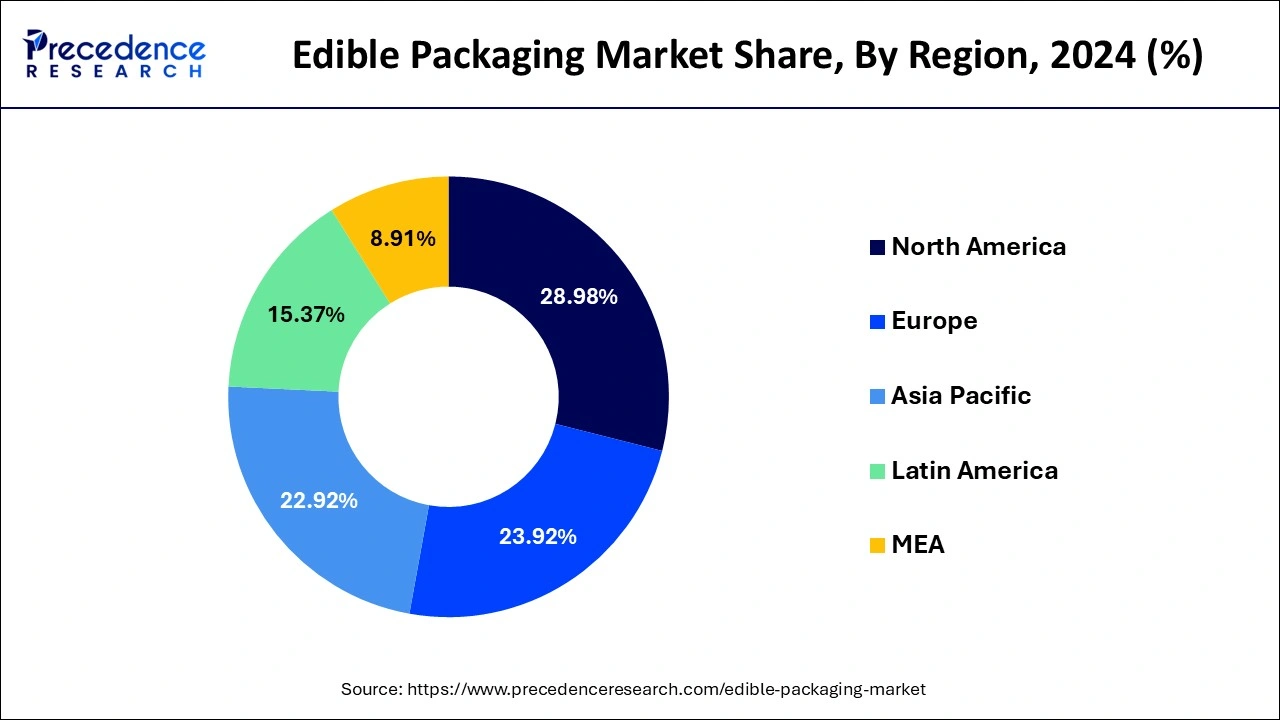May 2025
The global edible packaging market size is calculated at USD 1.1 billion in 2025 and is forecasted to reach around USD 1.81 billion by 2034, accelerating at a CAGR of 5.73% from 2025 to 2034. The North America edible packaging market size surpassed USD 300 million in 2024 and is expanding at a CAGR of 5.86% during the forecast period. The market sizing and forecasts are revenue-based (USD Million/Billion), with 2024 as the base year.
The global edible packaging market size was estimated at USD 1.04 billion in 2024 and is anticipated to reach around USD 1.81 billion by 2034, expanding at a CAGR of 5.73% from 2025 to 2034.

The U.S. edible packaging market size was exhibited at USD 240 million in 2024 and is projected to be worth around USD 430 million by 2034, growing at a CAGR of 6% from 2025 to 2034.

North America accounted for the greatest portion of the worldwide market share of 28.98% in 2024. Its dominant position in the worldwide market is attributed to the existence of sizable processed food and pharmaceutical sectors, as well as a sizable number of edible packaging makers. Furthermore, during the course of the forecast period, the market is expected to be driven by rising innovation in the edible packaging arena, notably in the United States.

From 2024 to 2033, the Asia Pacific market is anticipated to develop at the fastest rate. The main element driving the exceptional demand for the product in the region is rising consumer awareness of the negative effects of excessive plastic use for food packaging together with expanding plastics bans. Over the next years, rising food and beverage and pharmaceutical sectors are also anticipated to boost product demand. However, it is anticipated that high production costs and hygienic problems with product transportation may impede market expansion in the area.
To increase the shelf life of eating products and medicines, edible packaging is a thin substance that may either be removed before eating or utilized to wrap or coat the product. Regulations set out by the Food and Drug Administration (FDA) require packaging materials to conform to the characteristics of substances used in safe food products and to achieve the designation of "Generally Recognized As Safe" (GRAS). It is biodegradable since edible packaging is often made from biomass, such as plants and animals. The three main components of edible packaging or film are film-forming substances, plasticizers, and additives. Water, alcohol, or aqueous alcohol are utilized as an appropriate solvent to produce a film-forming dispersion (FFD) for edible films. The main components that make films include proteins, polysaccharides, lipids, and combinations or mixtures of these. Additionally, plasticizers and other useful additions are utilized to improve the protective qualities of edible film or packaging, including antioxidants, vitamins, antimicrobials, essential oils, colors, and chemical preservatives.
To prevent packaging failure, edible packaging is examined using a number of quantifiable quality indicators. Its moisture and gas barrier qualities, moisture adsorption capacity, microbiological stability, adhesion, solubility, cohesion, transparency, sensory, mechanical capabilities, and organoleptic properties are some of the important aspects that are assessed. Typically, edible packaging doesn't change the product's flavor, aroma, or appearance. However, recent innovation has made it possible for the product to add vitamins, flavoring agents, and fragrance volatiles to the packaged goods. According to the market's current developments, edible packaging options have gotten a lot of traction. The government's attempts to introduce customers to wholesome food that complies with consumption standards are the primary cause of this.
Along with leading market participants' shifting attention to the availability of novel types of sources devoted to edible solutions for foodstuff packaging, packaging technology is also improving.
The market for edible packaging is expanding due to the increased desire to eliminate the wasteful use of packaging materials. About one-third of the rubbish in the world is packaging. Recycling of solid trash is therefore necessary in order to decrease the garbage produced on land due to increased awareness of environmental issues including solid waste disposal and reducing the quantity of waste created in landfills. The use of edible packaging helps keep trash out of landfills.
The industry is expanding since edible packaging is being used more frequently to keep items fresher and longer. Growing safety concerns and efficient space use are once more driving industry expansion. The desire for edible packaging is being driven by the product's capacity to have a longer shelf life, which also minimizes waste. They are an excellent choice for the packaging of various food goods since they are simple to tamper with. As a result, the market is expanding due to the increased need for food goods to have longer shelf lives.
| Report Coverage | Details |
| Market Size in 2025 | USD 1.1 Billion |
| Market Size by 2034 | USD 1.81 Billion |
| Growth Rate from 2025 to 2034 | CAGR of 5.73% |
| Largest Market | North America |
| Base Year | 2024 |
| Forecast Period | 2025 to 2034 |
| Segments Covered | Material, Source, Packaging Process, End-User, and Regions |
| Regions Covered | North America, Europe, Asia-Pacific, Latin America, and Middle East & Africa |
Technological advancements in the packaging industry
Innovation in the edible packaging
The main end-user industries in the global edible packaging market are a) food & beverage and b) pharmaceuticals. The product segment is frequently used in the food and beverage sector to package a variety of food items, including fresh food, bakery and confectionery, infant food, functional foods, and dairy goods. The market for edible packaging is predicted to increase over the next several years as processed food demand increases globally as a result of improving lifestyles. Over the projection period, the pharmaceutical category is anticipated to grow at the fastest rate. In the pharmaceutical sector, edible packaging is mostly utilized for capsule packing. Global pharmaceutical, as well as nutraceutical industries, have been fueled by rising health consciousness; this is anticipated to have a positive influence on product demand from 2019 to 2025.
On the international market, protein is a substance that is mostly chosen. With a 48.9% global revenue share in 2024, the protein material category dominated the market. Casein, collagen, whey, gelatin, soy, plants, zein, and gluten are all components of protein films. Compared to polysaccharides and lipid-based films, protein-based films have stronger gas barrier characteristics. Due to the distinctive structure of proteins, these films also possess greater mechanical characteristics as compared to other material categories. The films' inferior mechanical strength and water vapor resistance compared to synthetic polymers, however, restricts their employment in end-use industries.
As a strong barrier to carbon dioxide and oxygen at low and moderate humidity, polysaccharides are also often utilized to create edible packaging. The primary sources of polysaccharides include chitin, starch, cellulose, gum, and others. Over the next years, rising global market development is anticipated to fuel demand for polysaccharides.
By Material
By Source
By Packaging Process
By End-User
By Geography
For inquiries regarding discounts, bulk purchases, or customization requests, please contact us at sales@precedenceresearch.com
No cookie-cutter, only authentic analysis – take the 1st step to become a Precedence Research client
May 2025
April 2025
January 2025
March 2025